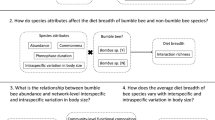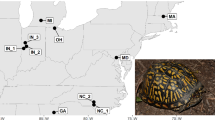Abstract
Split sex ratio theory predicts that when kin structure varies among colonies of social insects, in order to maximize the inclusive fitness, colonies with relatively high sister-sister relatedness should specialize in producing reproductive females, whereas in those with relatively low sister-sister relatedness workers should bias their sex ratio towards males. However, in order to achieve this, workers need to be able to reliably assess the type of colony in which they live. The information on colony kin structure may be encoded in cuticular hydrocarbons (CHCs), assuming that genetic variability translates accurately into chemical variability. However, in genetically heterogeneous colonies, too accurate information may encourage the pursuit of individual interests through nepotistic behavior and reduce colony efficiency or cause social disruption. In this study, we estimated how well variability of CHC recognition cues reflects colony kin structure in the ant Formica exsecta. Our results show that CHC variability does not covary with kin structure or the overall genetic diversity of the colony, and that patrilines and matrilines can have distinct CHC profiles in some but not all colonies. However, within-colony relatedness remains the key determinant of colony sex ratios. Based on our results, CHC variability cannot serve as accurate information on within-colony relatedness, kin structure, or full-sib affiliation, nor do workers seem to use colony CHC variability as a proxy for sex-ratio adjustment. The use of this type of information thus could lead workers to make mistakes, and it remains unclear how colonies of Formica exsecta adjust offspring sex ratio to their optimal value.



Similar content being viewed by others
References
Aitchison, J. 1986. The statistical analysis of compositional data. The Blackburn Press, Caldwell.
Akino, T. 2006. Cuticular hydrocarbons of Formica truncorum (Hymenoptera: Formicidae): Description of new very long chained hydrocarbon components. Appl. Entomol. Zool. 41:667–677.
Akino, T., Yamamura, K., Wakamura, S., and Yamaoka, R. 2004. Direct behavioral evidence for hydrocarbons as nestmate recognition cues in Formica japonica (Hymenoptera: Formicidae). Appl. Entomol. Zool. 39:381–387.
Aparicio, J. M., Ortego, J., and Cordero, P. J. 2006. What should we weigh to estimate heterozygosity, alleles or loci? Mol. Ecol. 15:4659–4665.
Benjamini, Y and Hochberg, Y. 1995. Controlling the false discovery rate: A practical and powerful approach to multiple testing. J. Roy. Stat. Soc. B 57:289–300.
Bonckaert, W., van Zweden, J. S., d’Ettorre, P., Billen, J., and Wenseleers, T. 2011. Colony stage and not facultative policing explains pattern of worker reproduction in the Saxon wasp. Mol. Ecol. 20:3455–3468.
Boomsma, J. J. 1993. Sex ratio variation in polygynous ants, pp. 86–109, in L. Keller (ed.), Queen number and sociality in insects. Oxford University Press, New York.
Boomsma, J. J. and Grafen, A. 1990. Intraspecific variation in ant sex ratios and the Trivers-Hare hypothesis. Evolution 44:1026–1034.
Boomsma, J. J. and Grafen, A. 1991. Colony-level sex ratio selection in the eusocial Hymenoptera. J. Evol. Biol. 4:383–407.
Boomsma, J. J., Nielsen, J., Sundström, L., Oldham, N. J., Tentschert, J., Petersen, H. C., and Morgan, E. D. 2003. Informational constraints on optimal sex allocation in ants. Proc. Natl. Acad. Sci. USA 100:8799–8804.
Bourke, A. F. G. and Franks, N. R. 1995. Social evolution in ants. Princeton University Press, Princeton.
Brown, W. D. and Keller, L. 2000. Colony sex ratios vary with queen number but not relatedness asymmetry in the ant Formica exsecta. Proc. R. Soc. B 267:1751–1757.
Chan, G. L. and Bourke, A. F. G. 1994. Split sex ratios in a multiple-queen ant population. Proc. R. Soc. B 258:261–266.
Chapuisat, M. 1996. Characterization of microsatellite loci in Formica lugubris B and their variability in other ant species. Mol. Ecol. 5:599–601.
Chapuisat, M., Liselotte, S., and Keller, L. 1997. Sex-ratio regulation: The economics of fratricide in ants. Proc. R. Soc. B 264:1255–1260.
Dani, F. R., Jones, G. R., Destri, S., Spencer, S. H., and Turillazzi, S. 2001. Deciphering the recognition signature within the cuticular chemical profile of paper wasps. Anim. Behav. 62:165–171.
Dani, F. R., Foster, K. R., Zacchi, F., Seppä, P., Massolo, A., Carelli, A., Arévalo, E., Queller, D. C., Strassmann, J., and Turillazzi, S. 2004. Can cuticular lipids provide sufficient information for within-colony nepotism in wasps? Proc. R. Soc. B 271:745–753.
Dani, F. R., Jones, G. R., Corsi, S., Beard, R., Pradella, D., and Turillazzi, S. 2005. Nestmate recognition cues in the honey bee: differential importance of cuticular alkanes and alkenes. Chem. Senses 30:477–489.
Fletcher, D. J. C. and Michener, C. D. 1987. Kin recognition in animals. Wiley, New York.
Goodnight, K. F. and Queller, D. C. 1999. Computer software for performing likelihood tests of pedigree relationship using genetic markers. Mol. Ecol. 8:1231–1234.
Goudet, J. 2001. FSTAT, a program to estimate and test gene diversities and fixation indices. Version 2.9.3.
Greene, M. J. and Gordon, D. M. 2003. Cuticular hydrocarbons inform task decisions. Nature 423:32–32.
Greene, M. J. and Gordon, D. M. 2007. Structural complexity of chemical recognition cues affects the perception of group membership in the ants Linepithema humile and Aphaenogaster cockerelli. J. Exp. Biol. 210:897–905.
Guerrieri, F. J., Nehring, V., Jørgensen, C. G., Nielsen, J., Galizia, C. G., and d’Ettorre, P. 2009. Ants recognize foes and not friends. Proc. R. Soc. B 276:2461–2468.
Gyllenstrand, N., Gertsch, P. J., and Pamilo, P. 2002. Polymorphic microsatellite DNA markers in the ant Formica exsecta. Mol. Ecol. Notes 2:67–69.
Haag-Liautard, C., Vitikainen, E., Keller, L., and Sundström, L. 2009. Fitness and the level of homozygosity in a social insect. J. Evol. Biol. 22:134–142.
Hasegawa, E. and Imai, S. 2004. Characterization of microsatellite loci in red wood ants Formica (s. str.) spp. and the related genus Polyergus. Mol. Ecol. Notes 4:200–203.
Keller, L. 1997. Indiscriminate altruism: unduly nice parents and siblings. Trends Ecol. Evol. 12:99–103.
Liang, D. and Silverman, J. 2000. “You are what you eat”: Diet modifies cuticular hydrocarbons and nestmate recognition in the Argentine ant, Linepithema humile. Naturwissenschaften 87:412–416.
Liautard, C., Brown, W. D., Helms, K. R., and Keller, L. 2003. Temporal and spatial variations of gyne production in the ant Formica exsecta. Oecologia 136:558–564.
Martin, S. J. and Drijfhout, F. 2009. Nestmate and task cues are influenced and encoded differently within ant cuticular hydrocarbon profiles. J. Chem. Ecol. 35:368–374.
Martin, S. J., Vitikainen, E., Helanterä, H., and Drijfhout, F. P. 2008. Chemical basis of nest-mate discrimination in the ant Formica exsecta. Proc. R. Soc. B 275:1271–1278.
Meiermans P. G. 2010. GenoDive. Version 2.0b20.
Nehring, V., Evison, S. E. F., Santorelli, L. A., d’Ettorre, P., and Hughes, W. O. H. 2010. Kin-informative recognition cues in ants. Proc. R. Soc. B 278:1942–1948.
Nielsen, J., Boomsma, J. J., Oldham, N. J., Petersen, H. C., and Morgan, E. D. 1999. Colony-level and season-specific variation in cuticular hydrocarbon profiles of individual workers in the ant Formica truncorum. Insectes Soc. 46:58–65.
Ratnieks, F. L. W., Foster, K. R., and Wenseleers, T. 2006. Conflict resolution in insect societies. Ann. Rev. Entomol. 51:581–608.
Ratnieks, F. L. W., Helanterä, H., and Foster, K. R. 2007. Are mistakes inevitable? Sex allocation specialization by workers can reduce the genetic information needed to assess queen mating frequency. J. Theor. Biol. 244:470–477.
Soroker, V., Vienne, C., Hefetz, A., and Nowbahari, E. 1994. The postpharyngeal gland as a “gestalt” organ for nestmate recognition in the ant Cataglyphis niger. Naturwissenschaften 81:510–513.
Starks, P. T., Watson, R. E., Dipaola, M. J., and Dipaola, C. P. 1998. The effect of queen number on nestmate discrimination in the Facultatively Polygynous Ant Pseudomyrmex pallidus (Hymenoptera: Formicidae). Ethology 104:573–584.
Stuart, R. J. 1988. Collective cues as a basis for nestmate recognition in polygynous leptothoracine ants. Proc. Natl. Acad. Sci. USA 85:4572–4575.
Sundström, L. 1994. Sex ratio bias, relatedness asymmetry and queen mating frequency in ants. Nature 367:266–268.
Sundström, L. and Boomsma, J. J. 2001. Conflicts and alliances in insect families. Heredity 86:515–521.
Sundström, L., Chapuisat, M., and Keller, L. 1996. Conditional manipulation of sex ratios by ant workers: A test of kin selection theory. Science 274:993–995.
Sundström, L., Keller, L., and Chapuisat, M. 2003. Inbreeding and sex-biased gene flow in the ant Formica exsecta. Evolution 57:1552–1561.
Trivers, R. L. and Hare, H. 1976. Haplodiploidy and the evolution of the social insects. Science 191:249–263.
Trontti, K., Tay, W. T., and Sundström, L. 2003. Polymorphic microsatellite markers for the ant Plagiolepis pygmaea. Mol. Ecol. Notes 3:575–577.
van Zweden, J. S., Brask, J. B., Christensen, J. H., Boomsma, J. J., Linksvayer, T. A., and d’Ettorre, P. 2010. Blending of heritable recognition cues among ant nestmates creates distinct colony gestalt odours but prevents within-colony nepotism. J. Evol. Biol. 23:1498–1508.
van Zweden, J. S. and d’Ettorre, P. 2010. Nestmate recognition in social insects and the role of hydrocarbons, pp. 222–243, in G. J. Blomquist and A.-G. Bagnères (eds.), Insect hydrocarbons: biology, biochemistry, and chemical ecology. Cambridge University Press, Cambridge.
van Zweden, J. S., Dreier, S., and d’Ettorre, P. 2009. Disentangling environmental and heritable nestmate recognition cues in a carpenter ant. J. Insect Physiol. 55:158–163.
Vitikainen, E., Haag-Liautard, C., and Sundström, L. 2011. Inbreeding and reproductive investment in the ant Formica exsecta. Evolution 65:2026–2037.
Wagner, D., Tissot, M., and Gordon, D. 2001. Task-related environment alters the cuticular hydrocarbon composition of harvester ants. J. Chem. Ecol. 27:1805–1819.
Wang, J. 2004. Sibship reconstruction from genetic data with typing errors. Genetics 166:1963–1979.
Wilson, E. O. 1971. The insect societies. Harvard University Press, Cambridge.
Acknowledgements
We thank V. Nehring for his help in analyzing the chemical data, J.J. Boomsma for critical discussions, and all members of the Copenhagen Centre for Social Evolution for providing a stimulating working environment. This work was supported by the EU Marie Curie Excellence Grant CODICES-EXT-CT-2004-014202 (to PdE), Academy of Finland grants 206404,121216, and 135975 (to LS), LUOVA graduate school in Helsinki (to EV), and the NordForsk research network “Social evolution in insects”. JSvZ was also supported by a postdoctoral fellowship from the Danish Council for Independent Research (09–066595).
Author information
Authors and Affiliations
Corresponding author
Electronic Supplementary Materials
Below is the link to the electronic supplementary material.
Appendix 1
(DOC 41 kb)
Appendix 2
(DOC 46 kb)
Rights and permissions
About this article
Cite this article
van Zweden, J.S., Vitikainen, E., d’Ettorre, P. et al. Do Cuticular Hydrocarbons Provide Sufficient Information for Optimal Sex Allocation in the Ant Formica exsecta?. J Chem Ecol 37, 1365–1373 (2011). https://doi.org/10.1007/s10886-011-0038-x
Received:
Revised:
Accepted:
Published:
Issue Date:
DOI: https://doi.org/10.1007/s10886-011-0038-x




